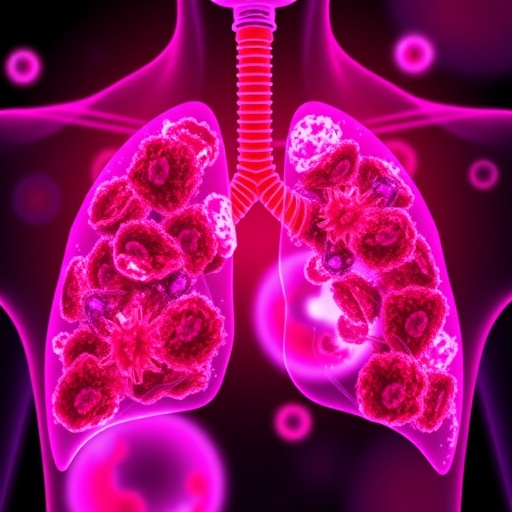In a groundbreaking study that challenges longstanding perceptions of immune cell functions, researchers at the Institute of Science Tokyo have unveiled a pivotal role for basophils—a rare class of white blood cells—in expediting recovery from acute respiratory distress syndrome (ARDS) in mice. Traditionally characterized as contributors to allergic reactions, basophils now emerge as crucial regulators during the resolution phase of ARDS, a severe and often fatal lung condition marked by intense inflammation and impaired gas exchange. The team’s findings, published in the European Respiratory Journal, offer a compelling narrative of how basophils strategically release interleukin-4 (IL-4), a cytokine that suppresses the hyperactivation of inflammatory neutrophils, thereby mitigating lung damage and facilitating tissue repair.
ARDS is clinically devastating, arising from diverse triggers such as pneumonia, severe viral infections including COVID-19, and sepsis. It manifests through the accumulation of protein-rich fluid in alveoli, which severely disrupts oxygen absorption. Despite advances in supportive care, mortality rates linger between 30% and 50%, underscoring the urgent need for innovative therapeutic strategies. Against this backdrop, the Institute of Science Tokyo’s research delineates an immunological pathway that could be harnessed to modulate inflammation resolution and improve patient outcomes.
Employing a rigorous experimental model, the investigators induced ARDS in mice via intratracheal administration of lipopolysaccharides (LPS), bacterial components known to trigger robust lung inflammation mimicking human disease. Comparative analyses between basophil-deficient and wild-type mice revealed stark differences during the recovery phase: mice lacking basophils exhibited extensive pulmonary injury, elevated neutrophilic infiltration, and sustained inflammatory responses. These results underscore basophils’ unanticipated yet critical immunoregulatory function beyond their classical role in allergy.
At the molecular level, single-cell RNA sequencing illuminated the mechanistic underpinnings of basophil-mediated resolution. Basophils in inflamed lung tissue were identified as a predominant cellular source of IL-4, a signaling molecule that orchestrates immune modulation. Genetic ablation of IL-4 production specifically in basophils exacerbated lung pathology and fluid retention during convalescence, affirming IL-4’s essential role. Mechanistically, IL-4 acts directly on neutrophils, downregulating the expression of genes that drive pro-inflammatory cytokine production—namely Il1a, Il1b, and Cxcl2—and genes that inhibit apoptosis such as Bcl2a1 family members. Through this modulation, IL-4 curtails neutrophil longevity and inflammatory potential, accelerating the resolution of lung injury.
This paradigm shift redefines basophils from being stigmatized as ‘bad actors’ to critical ‘good actors’ that enforce immunological balance during ARDS recovery. The discovery aligns with clinical observations linking low peripheral basophil counts to worse respiratory failure outcomes in septic and COVID-19 patients, providing a potential cellular biomarker for disease prognosis. Moreover, it opens intriguing avenues for therapeutic intervention by targeting the basophil–IL-4–neutrophil axis to attenuate inflammation without compromising host defense.
The implications of these findings reach far beyond basic immunology, touching the core challenges of translational and clinical medicine. Current ARDS management remains supportive with no FDA-approved pharmacotherapies to directly promote resolution of lung inflammation. The ability to harness or mimic basophil-derived IL-4 signaling might revolutionize treatment paradigms, offering a targeted approach to dampen neutrophil-driven tissue injury while preserving essential immune functions. However, the research team cautions that the cellular sources of IL-4 in human ARDS cases remain to be elucidated, highlighting a critical knowledge gap that future investigations must address.
Basophils representing merely 0.5 to 1% of circulating leukocytes have historically received limited attention due to their perceived subordinate role in immune responses. Yet this study contributes to an evolving appreciation of basophil plasticity, revealing their capacity to produce immunomodulatory cytokines and participate dynamically in inflammatory environments. Prior studies demonstrated basophils’ involvement in resolving skin inflammation and bacterial infections, but this ARDS context extends their relevance to critical pulmonary pathology.
The elucidation of the transcriptional changes governed by IL-4 in neutrophils further enriches our understanding of inflammation biology. Pro-inflammatory mediators such as IL-1α, IL-1β, and CXCL2 perpetuate neutrophil recruitment and activation, often leading to a deleterious feedback loop of tissue destruction and chronic inflammation. By repressing these factors, IL-4 effectively ‘reprograms’ neutrophils towards a less harmful phenotype and facilitates programmed cell death, which is essential for clearing inflammatory infiltrates. This mechanistic insight highlights potential molecular targets that could be leveraged pharmacologically.
Integral to this investigation was the application of single-cell RNA sequencing—an advanced technology that allows dissection of the heterogeneous immune cell milieu within the ARDS-injured lung at unprecedented resolution. This approach enabled precise identification of cellular contributors to cytokine landscapes and provided novel biomarkers of disease trajectory. The multidisciplinary team, spanning immunology, pulmonary medicine, and molecular biology expertise, exemplifies the collaborative approach required to unravel complex disease processes.
While the findings herald promising advances, translation from murine models to human clinical scenarios necessitates careful validation. Human ARDS arises from multifactorial etiologies and encompasses intricate immunopathology, thus future research must clarify whether basophils and IL-4 exert comparable protective roles in patients. Additionally, the prospects of modulating basophil function or IL-4 signaling raise questions about potential off-target effects, especially given IL-4’s known roles in allergy and asthma.
In summary, this landmark study reframes our immunological understanding of ARDS resolution, positing basophils and their secretion of IL-4 as key drivers that attenuate neutrophil-mediated lung inflammation. The delineation of this pathway not only fills a critical gap in ARDS pathogenesis but also paves the way for innovative therapies aimed at improving the dismal survival rates associated with this syndrome. As the global health community grapples with respiratory pandemics and severe inflammatory lung diseases, insights such as these are invaluable in steering the future direction of biomedical research and clinical care.
Subject of Research: Animals
Article Title: Emerging roles of basophils in the resolution of the acute respiratory distress syndrome
News Publication Date: 31-Jul-2025
Web References: https://doi.org/10.1183/13993003.01150-2024
Image Credits: Institute of Science Tokyo
Keywords: Immunology, Respiratory disorders, Basophils, Neutrophils, Inflammation, Cytokines, Molecular biology, Infectious diseases, Translational medicine, Blood cells




